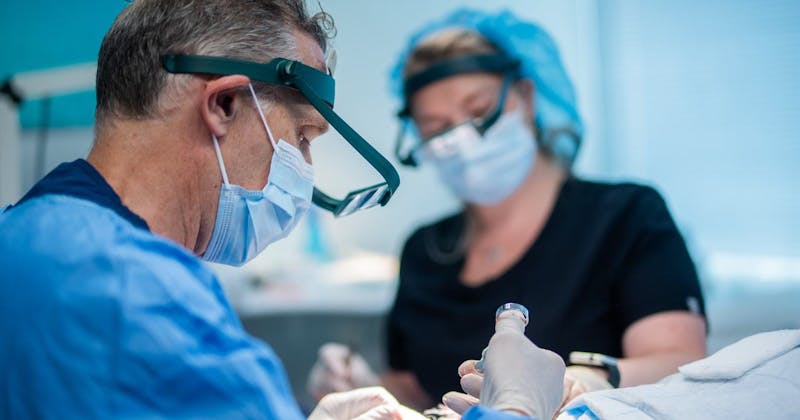Rooted in Results Let’s Get Growing
Hair loss is a symptom. We begin every journey by finding the cause, so your treatment plan isn’t just hopeful—it’s strategic, personalized, and proven to work.
Contact Our Team
What do you know about the latest hair transplant technology? If you suffer from male pattern baldness (MPB), you’ll want to read on. Hair transplants have been with us since the 1950s. Those of us in a certain age group remember hair plugs in the 1970s—and the often unsightly outcomes. The 1980s saw breakthrough technology with FUT (follicular unit transplant), a natural-looking grafting procedure still used today. The most recent advance is the no-shave FUE (follicular unit extraction) technique. Read on to find out more about this innovative technology.
The question is, what does the future of hair restoration look like? Read on to find out.
While balding men in their 20s and 30s have hair transplants, most patients are in the 45+ age group. Traditional FUE is the most popular technique today, but FUT and FUE each offer advantages and disadvantages. They have roughly the same level of effectiveness, with up to a 90% graft survival rate, but they have significant differences. More about these two techniques are below.
Also known as the Strip Method, in FUT (Follicular Unit Transplant) the surgeon removes a strip of skin from the back of the patient’s scalp, which is then divided into small groups of hair follicles called follicular units. The follicular units are then transplanted to the balding area of the scalp.
FUE is today’s most common hair transplant procedure, in which surgeons remove and transplant individual hair follicle units using a small circular tool, called a punch. The hair is then precisely transplanted into the balding area of the scalp
PRP (Platelet-Rich Plasma) therapy is an effective hair loss treatment that can also be used as an adjunct to FUE. The plasma’s high levels of proteins can increase blood supply to hair follicles, trigger hair growth, and increase graft growth rate. PRP also minimizes the chance of scarring and decreases the hair shedding that can occur after a hair transplant.
PRP treatment involves the surgeon drawing blood from your arm, separating platelets in a centrifuge, and injecting them into the balding areas of your scalp. This therapy is started three to four weeks after FUE, with most patients requiring three treatments four to six months apart for optimal results.
Precision Follicular Extraction (PFE™ ) is a modified version of FUE. The surgeon uses a smaller micro-FUE punch, along with an advanced diamond sapphire blade that extracts follicular units with micro-incisions for the most natural appearance, the least impact on the surrounding hair, the quickest and most comfortable healing process, and no downtime.
Despite its advantages, the no-shave FUE and PFE solution isn’t for everyone. They are the most time-consuming, with optimal results requiring multiple sessions. In addition, the technique requires a surgeon with highly specialized skills and is more costly than FUT and FUE.
No-shave FUE (follicular unit extraction), while still an emerging technology, is a breakthrough technology that is an increasingly popular option for the reasons below.
As the name implies, the technique eliminates a significant disadvantage of FUE, namely hair-shaving. The surgeon uses even smaller punches for the precise extraction of follicular units from the donor area.
Using highly specialized tools, no-shave FUE delivers the most natural-looking outcome.
Without visible bald patches from shaving, patients often feel less conspicuous, and more quickly resume their normal activities.
By not shaving the donor area, men can keep their current hairstyle. This is especially attractive for men in the 45+ age group, who typically want a longer look than the buzz and fade cuts popular among younger patients.
Although no-shave FUE was originally introduced in the early 2000s, many clinics do not yet offer this technique. Why? It is highly labor-intensive and time-consuming. Further, surgeons require specialized skills to accurately implant the follicles.
Without this accuracy, the procedure can result in an unnatural-looking pattern. The process also limits the number of grafts that can be safely harvested, leaving fewer donor follicles to treat progressive balding in the future.
Don’t fall for claims and online ads for surgical stem cell hair therapy. Products containing stem cells are available for topical application to the scalp. However, such products can not restore natural hair. Even more important, surgically injecting stem cells into the scalp is not an FDA-approved hair transplant procedure, meaning it is not proven safe and effective.
While currently not FDA-approved, research into stem-cell hair transplant therapy is promising. The FDA will likely approve this method after scientific evidence shows it is safe and effective.
Northeast Hair Restoration offers FUT, FUE, and new cutting-edge solutions like no-shave FUE, all performed by highly skilled surgeons and technicians. As techniques and tools evolve, we are committed to keeping pace with the latest innovations.
Surgical hair transplant methods continue to evolve, offering ever more successful results and convenience for patients. Northeast Hair Restoration is committed to providing exceptional hair transplant outcomes and staying ahead of industry trends.
We invite men and women concerned with balding to explore our high-quality surgical solutions. We also offer non-surgical therapies, including topical hair treatments, vitamins and supplements, and low-level laser therapy.
Our clinic and surgeons offer unparalleled expertise and the latest hair transplant technology available that are reliable, safe, and effective. Contact us today to schedule a consultation, learn about no-shave FUE, or explore our range of hair restoration solutions.